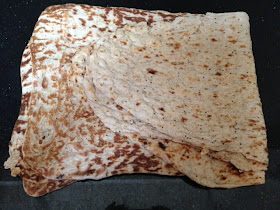By Heidi Noroozy
 |
| Photo by ph_en |
Half a lifetime ago, I lived on the grounds of a
Benedictine monastery in Vermont. Although I’d overcome a brief flirtation with
religion by then and was well on my way to becoming a non-believer, I’d often
slip into the back of the chapel in the evening when the monks gathered for
vespers. Along with the customary Gregorian chants, these Benedictines sang
beautiful songs written by one of the brothers. One song had a line that always
remained in my mind: “Man does not live by bread alone.”
These words stayed with me because, well, I beg to
differ. I could easily live on bread alone. Paired with a good Vermont cheddar
cheese is best, but I’ll settle for plain butter, and some varieties are
delicious with nothing at all.
I’ve always loved bread—even the rough loaves a neighbor
used to make from coarse, hand-milled flour. But when I moved to Europe, where
bread is serious business, I was in heaven. Different towns and regions have
their own local specialties: Joggingbrot in Stuttgart, a rye bread
packed with sunflower and pumpkin seeds, or salty Bretzeln (soft
pretzels) in Bavaria.
In Salzburg, Austria, I bought my bread from a tiny
bakery on the aptly named Brotgasse (Bread Alley). Identified only by the word Bäckerei
(bakery) in faded letters over the door, the shop was easy to miss. It had a
practical selection of baked goods and, unlike the elegant, tourist-packed Konditoreien
(pastry shops) on Getreidegasse only blocks away, no fancy tortes or
cream-filled pastries. It served oval loaves of rye bread, chewy in the
outside, soft on the inside. Rectangular, whole-grain breads filled with
sprouted rye, oats, and seeds. Large rounds of crusty sourdough. On the sweeter
side, the options were a simple Obstkuchen (fruit-topped cake) or sweet
roll. I knew I had been elevated to the exalted status of Stammgast
(regular patron) when the baker started tucking little extras into my bread
bag: a pair of Kipferl (crescent rolls) or even a slice of Zwetschkenkuchen
(plum cake).
 |
| Photo by Kochtopf |
From time to time, I’d head for the Franciscan monastery
on the far side of Domplatz and descend a narrow set of stairs into the
basement, where the monks baked huge loaves of sourdough rye bread. On baking
days, a wonderful yeasty fragrance wafted through square.
You might think it disloyal of me to abandon my favorite
bakery for the Franciscans, even temporarily, but it was such a treat to stand
in the bakery and watch the brown-robed monks pull fresh bread from enormous
ovens that stretched nearly all the way to the ceiling. The loaves weighed two
kilos each, so I always bought a Halber (half a loaf). Bread addict that
I am, even I couldn’t eat four pounds of bread before it got stale.
Years later, when I visited Iran for the first time, an
entirely new world of bread opened up to me. Like other Middle Easterners,
Iranians prefer flat bread with lots of crust. And they like it fresh, still
warm from the oven. When my husband was a boy, it was his job to fetch sheets
of warm flat bread from the neighborhood bakery—not just once a day but before every
single meal.
Like in Germany and Austria, Iranian bread has regional
variations. The ultra-thin lavash is made with white flour in Tehran but
comes in tastier whole-wheat varieties in the villages along the Caspian Sea.
The bakery in the Isfahan neighborhood where my sister-in-law once lived sold a
fragrant barbari, a thicker, oblong loaf with ridges down its length.
And Isfahan’s signature street food is beryan—ground mutton with savory
spices, mint, and slivered pistachios wrapped in a round sheet of taftoon,
which is much like an enormous tortilla.
In Paveh, a Kurdish village in the Zagros Mountains of
western Iran, I started each day with sheep’s milk cheese, homemade butter, and
sour cherry jam spread on the thinnest, laciest bread I’d every seen. It was
perfectly translucent when you held it up to the light. One morning, my hostess
added koloocheh, slightly sweet rounds of fried dough, a kind of donut
without the hole. Breakfast became my favorite meal of the day.
But my all-time favorite Iranian bread is sangak,
a whole-wheat flat bread studded with sesame and black nigella seeds. In Iran,
it is often still made the traditional way, long sheets of dough draped over
heated pebbles in a clay oven and hung on hooks from the wall to cool. The only
drawback to this age-old baking tradition is that sometimes small pebbles cling
to pockets in the knobby surface of the loaf, which can be hazardous to the
teeth.
This hearty flat bread is so versatile, I could eat it
with every meal—spread with hummus or smoky baba
ganoush, wrapped around kebabs fresh from the
grill, or torn up and stirred into the soupy portion of a one-pot, two-course
meal called dizi.
Half the fun of travel is the opportunity to expand my
culinary horizons and explore new tastes and textures. And visiting local
bakeries to sample new kinds of breads usually tops my agenda. It’s an easy
expedition—I just follow my nose.


Makes me want to bake my favorite cornbread!
ReplyDeleteOh, I love cornbread, Yves! Especially paired with a nice steaming bowl of chili. Or even all by itself. It's comfort food.
ReplyDelete